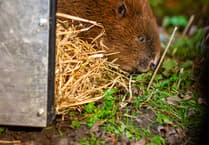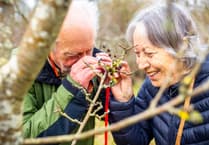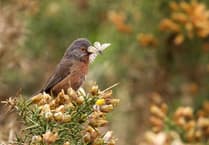The heathlands that surround us here might look like a wild barren landscape this time of year but it’s when the hard work begins to protect this special habitat.
The UK’s remaining lowland heath is distributed predominantly in southern England and what is left is fragmented, leaving animals and plants vulnerable to extinction in these isolated “island” habitats.
Around 80 per cent of the heathland which once stretched across the south of England has been lost to changes in land use, development and afforestation.
Many of the heaths in this area are protected under European Law, providing a habitat for rare bird, invertebrate, and 12 out of 13 of the UK’s native reptiles and amphibian species.
But did you know that heathlands wouldn’t exist without human intervention?
Initially established by hardy species, colonising the bare ground left after the last ice age, heathlands were the home for large herbivores whose daily grazing, browsing and movement kept this mosaic landscape open and free of woodland encroachment.
Once these, species were hunted to extinction, human activities such the grazing of herd animals, digging of peat for fuel, harvesting of heather filled in their ecological niche.
Since these heritage crafts and uses have fallen out of fashion, the land is managed to replicate these activities.
This can sometimes look dramatic, especially when it includes the felling or removal of trees, but it ensures our heaths stay healthy and allows the species that depend on them to thrive.
Heathers (three species are found locally: Ling, bell and cross-leaved heath) are one of the key plants we find on our lowland heaths.
Growing low to the ground, they are often out-competed by scrub and woodland, with quick colonising species such as birch, sycamore and scots pine shading out the heather.
They can also get taken over by invasive non-native species, such as Rhododendron, which rapidly degrade the value of the heathland habitat if left unchecked.
A mosaic of habitats is the best way to support a wide variety of biodiversity, providing a home for everyone. This means a healthy mixture of ages and species.
Woodland habitats are extremely valuable and any areas of Ancient Semi Natural Woodland, mature or veteran trees would never be removed, it’s all about the right tree in the right place.
Heathland land managers have to go through a strict process whereby felling licences have to be sought and tree felling works agreed with Natural England or Forestry England.
These works are done during the winter months and the log piles provide valuable habitats for insects, amphibians, and reptiles as they hide and hibernate.
How can you help?
If you’re out walking on the heaths this time of year, pay attention to signage about forestry works and take care around any large machinery you may come across.
If you’d like to find out more, we run a series of ranger led walks, or if you’re aged 16 to 25, why not join our Youth Action Day on Saturday, January 13, 2024 for a taster in a career in conservation and heathland management.
South Downs Youth Action on Shortheath Common, Saturday, January 13, 2024 at 9.45am. Tickets via Eventbrite here: https://tinyurl.com/3kuza556





Comments
This article has no comments yet. Be the first to leave a comment.